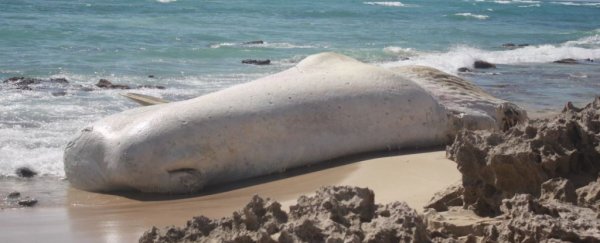It's been an exciting week for scientists in Hawaii after a puffy, disturbing-looking 'marshmallow' of a whale carcass keeps coming back to land. On top of that, a famous great white shark has popped up nearby, having travelled all the way from Mexico.
The poor, deceased sperm whale (Physeter macrocephalus) has been an unwelcome guest on the beaches of Hawaii over the last month, having been towed out to sea twice, but always washing back up on the beach.
Back on January 10, the whale carcass was first spotted in the Kewalo Basin, where a bunch of tiger sharks were enjoying the remains.
According to the Honolulu Star Advertiser, after it slowly drifted into shallow waters, authorities towed the whale back out to sea – 24 kilometres (15 miles) south of Oʻahu – Hawaii's third largest island.
"The thinking is that they [whale carcasses] often have sharks feeding on them, and if they get close to a beach, they could get close to shore where people are swimming," Kristi West, director of the marine mammal stranding program at the Hawai'i Institute of Marine Biology, told Kimberly Hickok at Live Science.
The whale itself has been decomposing for a while, and has lost its skin, revealing a very puffy white blubber layer, which lends the giant, disturbing marshmallow appearance to the remains.
According to authorities, the relocation of the dead whale didn't help for long, as it floated back to the Sand Island State Recreation Area by January 23.
On its way it had more run-ins with a few sharks, one of which has a bit of a reputation.
This particular great white (Carcharodon carcharias) is thought to be the infamous 'Deep Blue', a 6 metre (20 foot) female shark of at least 40 years of age; she was last spotted in 2013 in Mexico.
According to the Star Advertiser, diver and shark conservationist Ocean Ramsey had been monitoring tiger sharks in the area when Deep Blue appeared.
"We saw a few tigers and then she came up and all the other sharks split, and she started brushing up against the boat," Ramsey said to the Star Advertiser.
"She was just this big beautiful gentle giant […] We went out at sunrise, and she stayed with us pretty much throughout the day."
Deep Blue gained her fame back in 2014 with a Shark Week episode on the Discovery Channel. She's got her own Twitter account, and people are pretty excited that she's potentially resurfaced.
But even Deep Blue and her friends couldn't finish off the whale, and about two thirds of it ended back close to the shore once again.
After one more tow and return, scientists have decided to let the whale stay - its final resting place is near Campbell Industrial Park.
"The agencies involved have made the decision to leave the carcass in place, to let nature take its course and to let us learn from this carcass," said David Schofield, NOAA marine mammal response coordinator, in a press release.
 (Hawaiʻi Department of Land and Natural Resources)
(Hawaiʻi Department of Land and Natural Resources)
Scientists are trying to get as much information out of the carcass as they can, but it's not the easiest job in the world due to the decomposition and the smell. Fresh whales are much easier to investigate, but the team did a necropsy late last month, and the sperm whale is still showing some interesting secrets.
"The main thing we looked at was stomach contents to help us better understand the whale's diet. We did discover that the whale had not foraged for some time," West explained to Live Science.
This probably means the whale was sick, and died as a result of that.
Currently officials are asking people to stay clear of the whale, both for practical and cultural reasons. There could be shark activity still in the area, and according to those nearby, the stench reached half a mile (800 metres) away.
"From a cultural standpoint we always look at the whale's best interest, as they not only represent a large marine mammal, but in Hawaiian culture they represent our kupuna who traveled from far, distant places," said Noelani Puniwai, a Hawaiian Studies expert at the University of Hawaii Manoa.
"They are amazing messengers, as we can learn so much from them and help us to determine our own roles in the environment."
